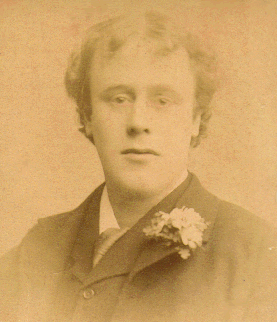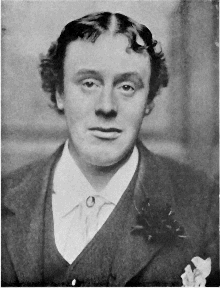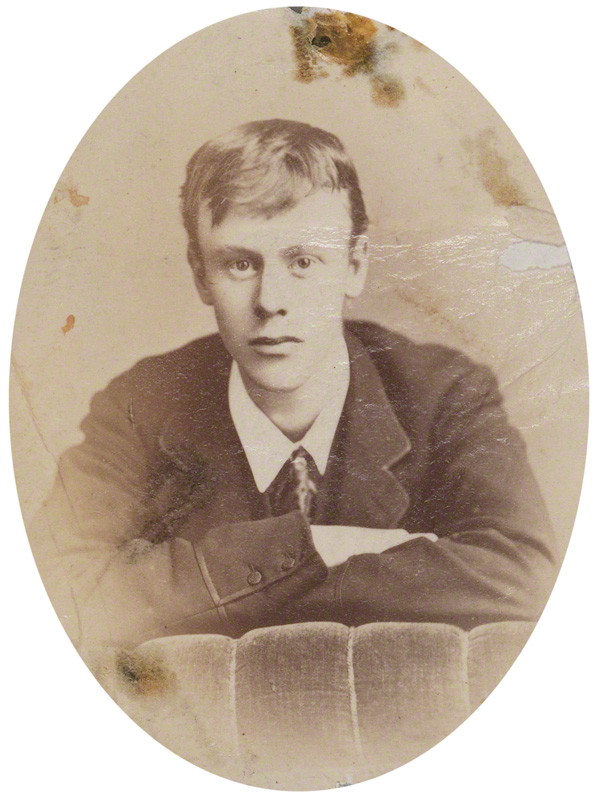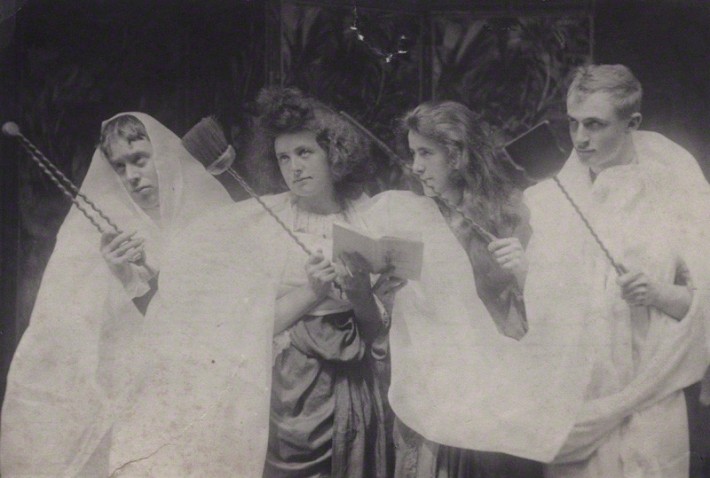
Count Eric Stanislaus Stenbock, Of Kings and Things: Strange Tales and Decadent Poems by Count Eric Stanislaus Stenbock, Ed. by David Tibet, with an afterword by Tim d'Arch Smith, Strange Attractor, 2018.
An introduction to the Decadent writer Stanislaus Eric Stenbock for the general reader, offering morbid stories, suicidal poems, and an autobiographical essay.
Described by W. B. Yeats as a "scholar, connoisseur, drunkard, poet, pervert, most charming of men," Count Stanislaus Eric Stenbock (1860--1895) is surely the greatest exemplar of the Decadent movement of the late nineteenth century.
A friend of Aubrey Beardsley, patron of the extraordinary pre-Raphaelite artist Simeon Solomon, and contemporary of Oscar Wilde, Stenbock died at the age of thirty-six as a result of his addiction to opium and his alcoholism, having published just three slim volumes of suicidal poetry and one collection of morbid short stories.
Stenbock was a homosexual convert to Roman Catholicism and owner of a serpent, a toad, and a dachshund called Trixie. It was said that toward the end of his life he was accompanied everywhere by a life-size wooden doll that he believed to be his son. His poems and stories are replete with queer, supernatural, mystical, and Satanic themes; original editions of his books are highly sought by collectors of recherché literature.
Of Kings and Things is the first introduction to Stenbock's writing for the general reader, offering fifteen stories, eight poems and one autobiographical essay by this complex figure.
Described by W. B. Yeats as a “scholar, connoisseur, drunkard, poet, pervert, most charming of men,” Count Stanislaus Eric Stenbock (1860–1895) is surely the greatest exemplar of the Decadent movement of the late nineteenth century.
A friend of Aubrey Beardsley, patron of the extraordinary pre-Raphaelite artist Simeon Solomon, and contemporary of Oscar Wilde, Stenbock died at the age of thirty-six as a result of his addiction to opium and his alcoholism, having published just three slim volumes of suicidal poetry and one collection of morbid short stories.
Stenbock was a homosexual convert to Roman Catholicism and owner of a serpent, a toad, and a dachshund called Trixie. It was said that toward the end of his life he was accompanied everywhere by a life-size wooden doll that he believed to be his son. His poems and stories are replete with queer, supernatural, mystical, and Satanic themes; original editions of his books are highly sought by collectors of recherché literature.
Of Kings and Things is the first introduction to Stenbock’s writing for the general reader, offering fifteen stories, eight poems and one autobiographical essay by this complex figure.

“…most charming of men.”
And that, my friends, is the perfect description of the ultimate strange flower: Count Eric Stenbock, the most outrageous poet you’ve (probably) never heard of.
The four slim volumes which Stenbock published in his lifetime – three of poetry and one of short stories – are ridiculously rare, the only biography dedicated to him long out of print. Written by John Adlard, it bears the title Stenbock, Yeats and the Nineties, but apart from supplying that alluring opening description, Yeats is barely mentioned in the book; it appears the publishers were hoping a better known name might improve the book’s chances. Of his subject Adlard curtly states at the outset, “he was a sick man, a pervert, and his life was short.”
Stenbock was born in 1860 to an aristocratic Baltic German family and numbered a queen of Sweden among his ancestors. Largely raised in England, he produced his first collection of poetry in 1881 while at Oxford. Love, Sleep and Dreams was dedicated to Charles Bertram Fowler, a boy with whom Stenbock was infatuated, who died of consumption at age 16; Stenbock himself was ill for much of his short life, shortening the odds of an early death with alcohol and opium.
Stenbock inherited extensive estates in Estonia in 1885, and must have been quite the eyeful when he turned up in a green suit with an orange silk shirt. The conservative Baltic German gentry (a milieu memorialised by Marguerite Yourcenar in her novel Le Coup de grâce), were not ready for such exotic plumage. There was more to come: Stenbock set about turning his grand neo-classical manor into a hothouse cum menagerie, with red walls, tropical blooms and a variety of free-range fauna, including tortoises, monkeys, parrots, doves, lizards and salamanders.
The count’s bedroom featured a pentagram over the bed, and there he would smoke opium and play piano late into the night, emerging the next day – late, naturally – in a dressing gown with a snake wrapped around his neck. Even these quirks were not enough to dissuade misguided local landowners who hoped their marriageable daughters might catch Stenbock’s eye; when invited to dinner with them he would turn up with a pet monkey.
But realising there was more to life than freaking out Baltic blue bloods, Stenbock returned to Britain in 1887. Both his life and work perfectly captured the mood of the Decadent movement then in the ascendant, and not surprisingly this doomed, bizarre being made a lasting impact on his contemporaries. Arthur Symons, for instance, memorably categorised him as “bizarre, fantastic, feverish, eccentric, extravagant, morbid and perverse…” (which makes you realise how much more fun Snow White and the Seven Dwarves would have been as a Yellow Book rather than a Golden Book publication).
Symons deserves to be quoted at length on the subject of Stenbock: “There was in him something fascinating, disconcerting; the manners of the man might easily have become repulsive; yet, all the same, he might, for all I knew, have strayed out of a wild beast show, without any intention of returning thither. Then, as always, he was one of the most inhuman beings I have ever encountered; inhuman and abnormal; a degenerate, who had I know not how many vices.”
Writer Ernest Rhys remembers Stenbock taking five sugars in his tea and playing a Ukrainian lullaby on the piano. In the poet’s rooms he was welcomed by Stenbock with his “familiar” mounted on his shoulder: a toad called Fatima. Elsewhere Rhys discovered a devotional red lamp burning between a Buddha and a bust of Shelley. This eccentric shrine was even visited by Oscar Wilde himself, though he made the mistake of lighting a cigarette from that red lamp, much to his host’s horror.

Stenbock’s grandfather had once left him a sum of money, to be claimed not when but “if” he reached 21 and the poet’s persistent ill health mean he experienced his mortality more vividly than most. There may have been an element of camp to Stenbock’s morbid fixations, but in the 1890s his vision, dark at the best of times, was sunk in Stygian gloom. In 1893 he published a mournful collection under the name The Shadow of Death; the following year he claimed “the highest odds on my life now is five weeks”.
By this time, things were getting really weird. Stenbock could consume nothing heartier than bread and milk and his alcoholism brought on terrifying deliriums. Travelling for various cures, he was steadily losing his grip on sanity, accompanied everywhere by a dog, a monkey and a life-sized doll, whom he referred to as “le petit comte” and insisted was his son.
April 26, 1895 would prove a fateful date for both Oscar Wilde, the public face of Decadence, and Eric Stenbock, arguably its purest exponent. For Wilde, it was the first day of the trial which would eventually see him sentenced to hard labour, which would in turn hasten his death.
For Stenbock, that appointment could be postponed no longer. In one of his last verses he had exclaimed “Why/Should I, whose shaft has withered without bloom/Seek fallen flowers and fruit? – leave me alone to die”. He got his wish; at home in Brighton, he hit his head on a grate after lashing out at a member of his household with a poker and died, aged just 35. - James J. Conway
https://strangeflowers.wordpress.com/2010/04/26/scholar-connoisseur-drunkard-poet-pervert/
Few dates embody the “decline” inherent in the original French definition of décadence more than April 26, 1895, signalling as it did the fall of two of the figures most readily associated with capital ‘D’ Decadence. One hundred and twenty years ago today, Oscar Wilde was facing the first day in his trial for gross indecency, the start of the precipitous decline which would end five years later in his premature death. On the same day, Count Eric Stenbock expired in a fit of pique, gripped by madness, alcoholism and addiction, aged just 35.
In his life and afterlife Stenbock never attracted a fraction of Wilde’s renown, but no-one in the present day has done as much to change that as David Tibet. Recently when I posted a news report concerning the restoration of Stenbock’s ancestral seat in Estonia, David himself stopped by to comment. His interest in Stenbock is typical of his boundless curiosity. As prolific as he is with his group Current 93 and numerous other musical and artistic projects, David’s manifold ancillary interests are no mere sidelines, and he has brought passion and scholarship to subjects as diverse as Outsider artist Madge Gill and Coptic theology. Between 1996 and 2004, his Durtro Press imprint published more or less everything the Count wrote, works which were otherwise impossible to come by. During this period Current 93 issued the mesmerising sonic séance Faust, based on Stenbock’s story of the same name. The summit of David’s Stenbockian activities will be an anthology of the Count’s collected works, which will include numerous previously unpublished pieces.
David has generously agreed to answer some questions to mark this auspicious anniversary. It’s a rare pleasure to hear someone talk so knowledgeably about a beloved figure.
James J. Conway: You’ve been engaged with the life and work of Eric Stenbock for many years now. What was your first encounter with the Count, and what was it about him that captured your imagination?
David Tibet: I think the first time I heard of Eric was in 1979 when I read Francis King’s popular biography, The Magical World of Aleister Crowley. Obviously I bought it because I was interested in Crowley, but King writes somewhere when he’s talking about the people that had influenced Crowley, or were perhaps aesthetic bedfellows, “Stenbock made an attempt to understand his own homosexuality in terms of traditional occultism, eventually coming to view his condition as an aspect of vampirism and lycanthropy, torn between Catholicism and diabolism, he died, deluded that a huge doll was his son and heir, in 1895.”
In the 1990s I started collecting M. R. James first editions and became interested in other supernatural fiction of a similar antiquarian bent to M. R. James. I was having lunch with Tim d’Arch Smith and [he] said to me, “have you ever read Stenbock’s Studies of Death?”. I vaguely knew the title and then I remembered what I’d read about Stenbock. Tim said that Edwin [Pouncey], our mutual friend from Sounds – Savage Pencil – had a copy and might be willing to sell it. He did and I took it home, laid on the couch, read it, and became totally obsessed by Stenbock. Edwin said to me, “Studies of Death is rare but the three books of poetry are impossibly rare”, and that I would never get them; even the British Library didn’t have them all. But the obsession became so strong that I determined I would get these books. I also bought [John] Adlard’s excellent biography [Stenbock, Yeats and the Nineties] , and that set me on the quest. It really took me over and I just followed up every possible lead I could.
Perhaps I’ve always been drawn to people whose work I feel has been unjustly overlooked, people like Louis Wain, Tiny Tim, whose work I love but had been forgotten more or less, Shirley Collins, such a beautiful person, such a beautiful voice and forgotten for a long time. Also I thought of The Quest for Corvo. There wasn’t much beyond Adlard and a few other bits and pieces, Christmas with Count Stenbock, the few mentions in Ernest Rhys’s autobiographical writings. But I kept thinking about Enoch Soames in Max Beerbohm’s book where Enoch Soames says “I’m a diabolist, a Catholic diabolist.” So it also linked up with other things that have always fascinated me: grimoires, Catholicism, diabolism; Huysmans and his À Rebours and Là-Bas were huge influences on me in the early years of Current and they’re still books that I love.
JJC: John Adlard describes his subject as a “pervert” who “achieved almost nothing”, Arthur Symons called him a “failure”, while a contemporary review of his work declared “it must be a parody”. Do you have any sympathy for their views?
DT: Odd that Adlard called Stenbock a pervert. Adlard, I know was heterosexual and married, but he obviously had a great fondness for this pervert. But it seems even in 1969 a peculiarly blunt moral judgment. Symons did call him a failure although of course Symons in the period you refer to had been through a massive nervous breakdown and mental collapse. The contemporary view declaring “it must be parody” – that’s very much High Victorian Muscular Christianity in play I think. One of the things I love about Stenbock’s work is, for “the king of the Decadents” his writing style is remarkably undecadent. I think he was influenced by Balzac, who he loved; it was actually quite a plain, unornamented style. His poetry is sometimes very mauve, very purple. I don’t have any sympathy but I like the fact that they gave those views, because they were giving views on someone who was barely known. So God bless Eric – some people noticed him while he lived.

JJC: Stenbock’s first book of poetry came out in 1881, and examined themes of illness, decay and morbidity before Decadence was even established as a literary movement. He actually owned a hothouse in 1885, only a year after Huysmans published À Rebours. Do you think Stenbock deserves more recognition as an innovator in developing Decadent themes, both in his work and in his life?
DT: People come to his work expecting something incredibly Decadent, but if you look at the stories in Studies of Death, which is the one that people had the most access to, they’re not terribly Decadent. “True Story of a Vampire” is certainly Decadent. If you look at “Faust”, which I published for the first time, that is a masterpiece of Catholic, diabolist Decadence. Hopefully when I put out my edition of the collected works of Stenbock it will make things a lot easier and people can make their own mind up about him. When I first read Stenbock I fell in love with him. I fall in love quite easily with writers and poets and artists, especially when they’re no longer living and unable to disappoint me. Stenbock means so much to me, his work means so much to me – his success and his failure.
When I was trying to find the last of the first editions, the only one I didn’t have at the time was The Shadow of Death and I was on the phone with Martin Stone, one of the best book dealers, and a member of the Pink Fairies, one of my favourite bands. He had a lead on a copy and every time he rang up about it, a blue butterfly would come into my room from outside and I still believe that was Stenbock coming in the form of a butterfly, about which he often wrote. I believe that Stenbock was looking down on me and wanted me to help bring him back to public awareness or at least do the best that I could. I think Stenbock’s time will come. He’s a moving person; I met a lot of kindness in my search for his works. I feel I was in the right place at the right time. And it had always surprised me that no-one else had looked into him much since Adlard. For example, Adlard mentions all these papers at I Tatti [the Florence villa inhabited by Bernard Berenson and Stenbock’s childhood friend Mary Berenson, née Smith], and he says they’re of no literary value, or something dismissive like that, but nobody else had been there to look at them.
JJC: Stenbock’s bedroom in Estonia was notoriously adorned with a pentagram, he had some kind of shrine in his London house, but he was also conspicuously Catholic. How would you characterise Stenbock’s beliefs?
DT: I went to Stenbock’s bedroom at Kolk. Unfortunately there was no pentagram there any more although there was some nice blue-green wallpaper, although whether it was original or not, who knows. Again the shrine – it’s just difficult to know what the truth is. There’s traces of the usual Decadent pantheism and classical religion in Stenbock’s poetry, especially, and a heavy Catholicism. I have a letter in which his step-father [is] writing to his uncle; says “Disastrous news: Eric has converted to Catholicism.” And he goes on to say that “I hope in the fullness of time when Eric matures he will choose a less ridiculous religion”. He’s also suggesting to the uncle that they get Eric to join the Tsar’s army. So I think his family were pushing him to be more martial and masculine but realised they were swimming against Stenbock’s tide.
JJC: You commented that there is often no proof, positive or negative, for the more outlandish tales about the count, like the life-sized doll he claimed as his son.
DT: A couple of Stenbocks that I’ve met – I know three Stenbocks – don’t know where it comes from, they don’t believe it’s the case. I hope it’s the case, it’s a fantastic story and it’s so associated with Stenbock. Let’s just say it is the case but there’s no proof of it and I couldn’t find any papers which mentioned it, including diaries connected to Stenbock by people who knew him.
JJC: There’s also a story that Oscar Wilde visited Stenbock’s house…
DT: The meeting at Stenbock’s house when Wilde lights his cigarette from the flame in front of the bust of Shelley – again a fantastic story. Timothy d’Arch Smith thinks it isn’t true and I’ve never seen it anywhere else. Again it doesn’t mean it’s not true. Yeats met Stenbock and there’s Yeats’ record of his meeting with Stenbock [a thinly fictionalised account in The Speckled Bird, which David kindly brought to my attention]. There’s no record that Wilde met Stenbock. I always check out Wilde indices to see if there is any mention of Stenbock, but I never see them. Stenbock did know Beardsley well and would buy Beardsley drawings.
JJC: Stenbock’s brand of arch, macabre Decadence will always appeal to a select temperament, but do you think the Count’s profound awareness of his own mortality and the sense of dissolution at the end of the 19th century have any resonance for a broader public in the present day, when we seem hell-bent on engineering our own decline?
DT: I think that people who are hell-bent on engineering their, as well as our own decline, are not going to take the time to read or even consider the meaning of three slim volumes bound in vellum of Decadent, tortured, vampiric, homosexual poetry. Maybe they should – I think there’s a message there for all of us. Stenbock still seems to be a great outsider. Even if you look at d’Arch Smith’s beautiful book Love in Earnest on the Uranians – an absolutely fantastic book, I can’t recommend it enough – even there he stands out, not one of the crowd, just ploughing his own strange furrow, somewhere between despair and ecstasy. He ended up in despair. Maybe there’s the resonance for the broader public in the present day: despair.
JJC: You’ve reissued Stenbock’s work in the past, including unpublished material. I know a lot of people are looking forward to the forthcoming anthology. What fresh discoveries await us?
DT: There’s a lot of unpublished material in my edition, lots of letters, there’s a fantastic unfinished – or incomplete – lost civilisation story. There’s the famous almanac with the sacred days of the week and the colours that the Idiot Club [a group formed by the young Stenbock and Mary Berenson along with two of her siblings] wrote, some photographs that people haven’t seen before. Not a huge amount of short stories that haven’t already been published. There’s poems for children. I’ve been working on it for so long and I wish it had been finished by now. Of course it’s a hobby of mine and not my main work. I hope to get it out for the end of this year.
- James J. Conway https://strangeflowers.wordpress.com/2015/04/26/the-quest-for-stenbock/

Studies of Death, Snuggly Books, 2018. [1894.]
During his lifetime the eccentric Count Eric Stenbock published a single collection of short stories, Studies of Death. These seven tales, at once feverish, morbid, and touching, are a key work of English decadence and the Yellow Nineties. This disquieting collection, long out of print, is here presented for the first time in paperback.

Faust


https://archive.org/details/CountStanislausEricStenbockTheShadowOfDeath26StudiesOfDeath/page/n0
ReplyDelete